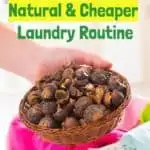
Have you given your laundry room much thought recently?
It’s a mistake if you haven’t.
Washing your clothing might seem like a harmless activity, but the truth is that whatever your whites and brights are washed with will be in contact with your skin for close to 24 hours a day.
Equally alarming, many of the laundry routines we never think twice about are wasting fossil fuels and damaging the planet’s fragile ecosystems.
For that reason, it’s crucial to think critically about the ways you’re washing your clothing so that you can choose the products and routines that are best for your health and the health of the environment.
What’s Wrong with Standard Laundry Practices?
Over 80,000 chemicals are used in commercial products in the United States today, but just a small amount have been tested for toxicity.
Rather, the EPA’s standard policy is to assume that most compounds are “safe until proven otherwise” and only those classified as “likely toxic” undergo rigorous testing.
This allows a lot of compounds to slip through the cracks, and laundry products are a common place for them to show up.
Here are some categories of ingredients to be concerned about.
- Fragrances: Companies often use the term ‘fragrance’ so they don’t need to disclose precisely what the product contains. Many fragrance agents are skin irritants, so avoid them when possible.
- Surfactants: some forms of these cleansing agents, including quaternium-15, diethanolamine, and nonlphenol ethoxylate show evidence of causing skin irritation, nerve toxicity, and acting as carcinogens.
- Stabilizers: Many detergents contain olyalkylene oxide or ethylene oxide to extend the shelf life, which can cause skin irritation.
- Brighteners: While compounds like naphthotriazolystilbenes, benzoxazolyl, and diaminostilbene disulfonate are added to detergent to brighten your clothes, they are linked with negative developmental and reproductive effects.
If you don’t want to ingest these ingredients, you shouldn’t permit them to touch your clothes. Skin is the body’s largest organ, and it’s porous enough to allow trace amounts of chemicals to pass through. After all, that’s how CBD oil and nicotine patches work.
Wearing potentially harmful compounds on your clothes is simply asking for them to enter your bloodstream.
Environmental Impacts of Commercial Detergents
Beyond your own health, commercial detergents can wreak havoc on aquatic life as well.
Their surfactants change the tension level of water in ways that allow fish and amphibians to absorb pesticides and other compounds through their skin more easily. For instance, the surfactant phosphate is common in detergents, and it strips the external mucous layer off fish and leaves them vulnerable to bacteria and parasites. Even trace amounts of phosphate in the water can lower breeding rates, kill fish eggs, and trigger algae blooms that diminish the water’s oxygen levels.
The plastic container your detergent comes in isn’t any better, as it contributes to the 185 pounds of plastic each American throws away every year, and possibly join the five trillion pieces currently floating in the ocean.
Pin This To Save For Later
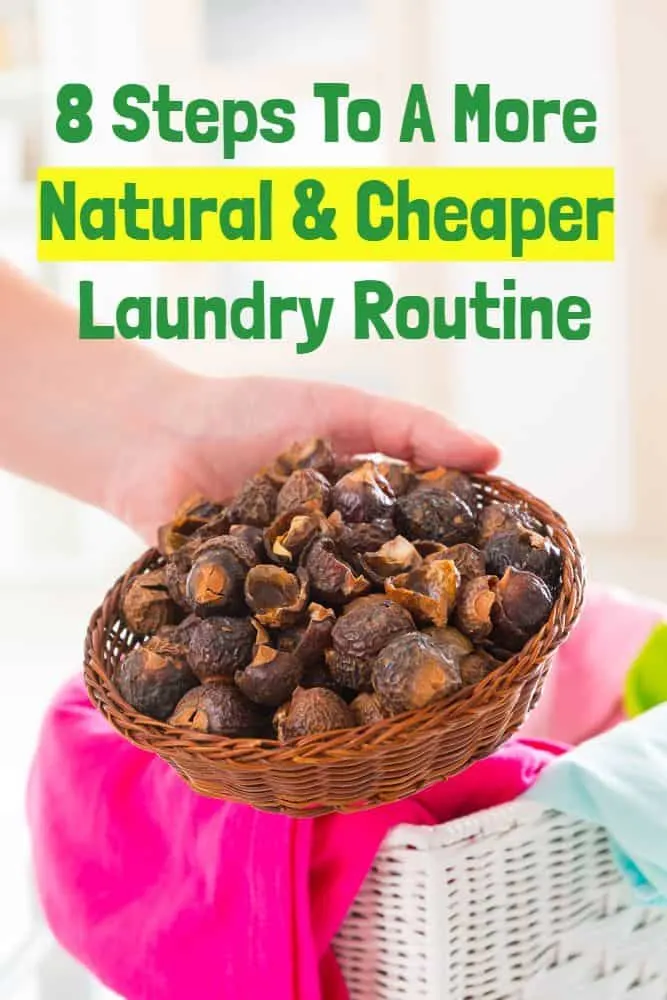
8 Simple Steps For A More Natural & Affordable Laundry Routine
Now here’s the good news.
You don’t need to expose your household to unhealthy laundry chemicals any longer. It’s easier than you think to naturalize your laundry routine, and many of these tips require nothing but ingredients you already have at home – saving you time and money in the process of becoming more sustainable.
Below are eight suggestions for more environmentally conscious laundry.
1. Wash Clothes with Soap Nuts
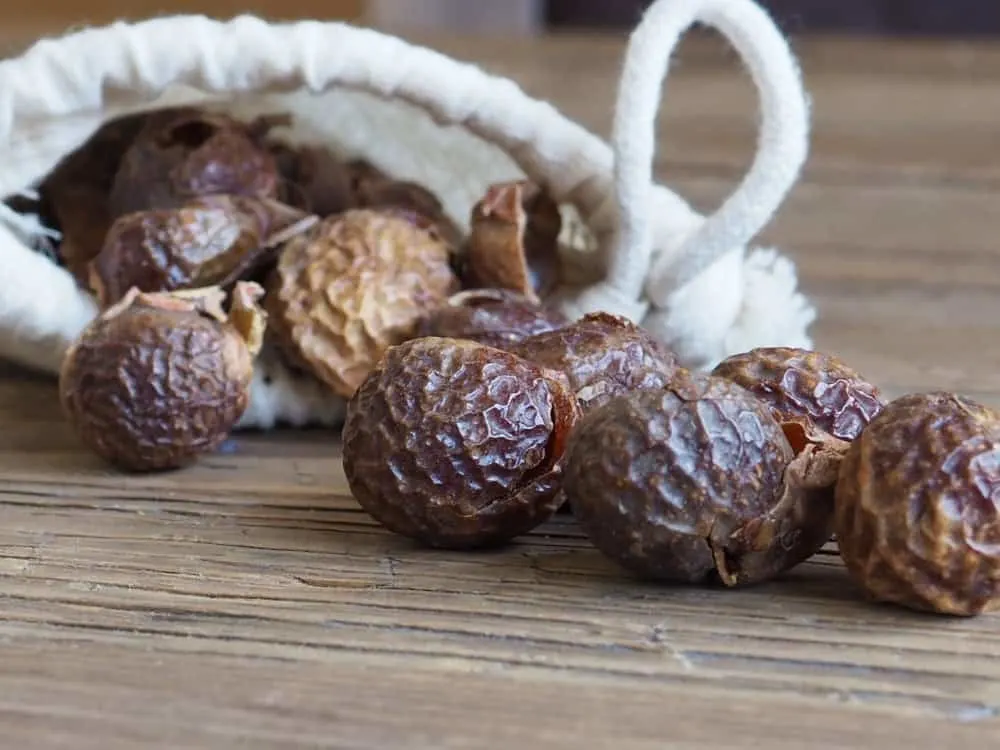
Nuts and laundry don’t seem to go together, but the fruit from the Mukorossi tree is a surprisingly effective laundry solution.
Native to the Himalayas, these leather-like berries contain a natural surfactant called saponin that works with water to agitate the dirt off clothing, and then binds to the loose dirt molecules so that they get washed down the drain.
In this way, washing your lightly soiled clothes with soap nuts leaves them as clean as when you use conventional detergents, and you aren’t left with artificial fragrances at the end.
Washing your clothes with soap nuts couldn’t be simpler.
You merely need to put 5-7 nuts in a small drawstring bag (this is usually included when you purchase them) and toss it into your washing machine.
You don’t need to worry about taking them out during the rinse cycle and can merely remove them when you transition the load to the line or dryer.
Best of all, each nut can last for up to ten washes, and they only need to be replaced when they become papery and transparent.
Your worn out nuts are a great addition to the compost pile. Within weeks they will completely biodegrade, benefiting your soil health in the process.
How to Use Soap Nuts for Liquid Laundry Detergent
While soap nuts can be used fresh for clean laundry, it’s also possible to turn them into a potent laundry soap for more concentrated cleaning.
There are two primary methods: stovetop and an overnight soak.
To use the stove, bring four cups of water to a simmer and add one cup of soap nuts, letting them simmer uncovered for ten minutes. Remove the pan from heat, cover it, and let it cool. You can then mash the nuts with a potato masher until the liquid thickens. Strain out the nut remnants with a mesh sieve, and store the resulting detergent in a glass container in the fridge for a few weeks or frozen into ice cubes. To use, pour a half cup or a few ice cubes into the washer.
Alternatively, you can soak the nuts overnight in four cups of water, liquifying the softened nuts in the blender the next morning. Make sure you do this in small batches so that the nuts don’t foam too much. As before, strain the nut fragments before using.
2. Make Homemade Laundry Detergent
It’s easier than you think to make and use homemade laundry detergent.
It’s possible to make powdered or liquid types, and you maintain full control over the fragrances and other ingredients that are included.
For liquid soap, collect two bars of a natural brand of soap and one cup each of washing soda and borax or baking soda. Grate the soap into a large pot and fill it with enough water to just cover the soap. Heat on low and stir until the soap is dissolved. Take a bucket and fill it with 4.5 gallons of water, and then add the washing soda and borax or baking soda. Combine with the soap mixture, and stir to incorporate. Your soap will thicken as it cools. This gives you five gallons of soap, and you’ll need to use just ¾ cup per load.
If you prefer powdered washing soap, grate two bars of natural soap and combine them with four cups of washing soda. Store the mixture in a large container and use one to two tablespoons per regular load.
3. Make a Natural Stain Remover
There’s no reason to turn to harsh bleaching agents to restore your clothing to its stain-free glory.
You can make a DIY stain remover with 1 tsp baking soda, 4 tsp dish soap, and 8 tbsp hydrogen peroxide.
Combine all ingredients and apply directly to stains, letting it set for up to an hour before washing your clothes as usual.
4. Buy Safer Store-Bought Detergent
If making homemade laundry soap isn’t for you, there are still ways you can ensure the products you use are better for the planet.
Keep in mind that greenwashing practices are often used to make detergents look more eco-friendly than they are, so read ingredients lists carefully to ensure you know what you’re buying.
One smart way to gauge the safety of a product is to look up its ingredients in the Environmental Working Group database.
You’ll get a safety ranking for each component and any common concerns associated with them for both human and environmental health.
Some safe options to consider include Arm and Hammer Super Washing Soda, Attitude Laundry Detergent, and Biokleen laundry detergent.
5. Make and Use Homemade Dryer Sheets
Store-bought dryer sheets can have an overwhelming scent, and it’s hard to be sure the ingredients they contain are safe for your skin.
The good news is you can make your own using 100% safe ingredients.
Take small squares of cotton cloth and soak them in a jar that contains one cup of white vinegar and 20 drops of the essential oil of your choice (lavender is a classic option).
You can use one dryer sheet per load of laundry. The vinegar scent dissipates as your clothing dries, but a small amount of essential oil scent will remain.
Note: There are many other ways to scent your laundry in the dryer! Consider using naturally scented dryer balls or spritzing clothes with essential oil-scented water before running the cycle.
6. Use Wool Dryer Balls
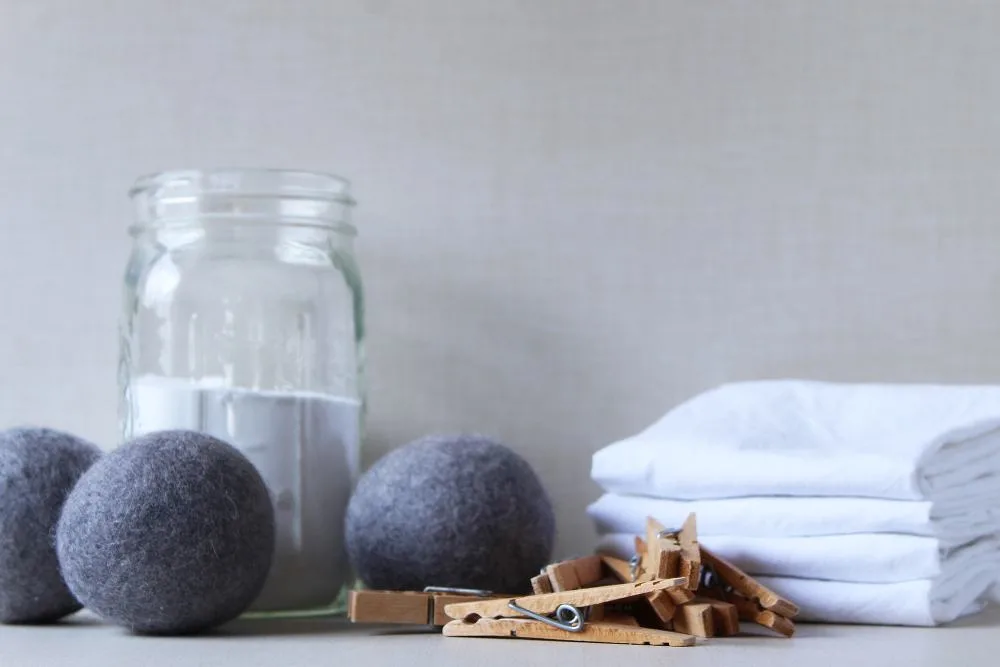
You may be surprised to learn that your dryer is one of the biggest energy sucks in your home. An average electric dryer costs more than $100 in energy costs to operate each year, so you can save money and fossil fuels by running yours with wool dryer balls.
These balls are designed to absorb moisture, so tossing two into the dryer cuts down drying time while fluffing your clothing and removing static in the process.
Most balls can be used for over 1,000 loads, and they break down naturally in the compost when you’re done with them.
7. Optimize Your Dryer Use for Maximum Energy Efficiency
If you aren’t ready to give up the dryer for good, there are ways to use it more sustainably.
Keep the following tips in mind to ensure you’re getting the maximum benefit for the smallest energy and environmental cost.
- Run full loads: don’t waste electricity powering a half-empty dryer!
- Choose fast spin settings: The more your clothes move, the quicker they dry, and the less energy they use overall.
- Keep the room warm: dryers work more efficiently in a warm space because it takes less energy to warm the air they use.
- Clean out the lint filters: if your machine is clogged with lint, it spins slower and struggles to get up to temperature. Clean the lint after they use to keep things efficient.
- Invest in energy efficiency: look for Energy Star certified appliances to save approximately one-third of the energy usage for every load. If possible, choose a front loading dryer because they tend to pull water out of clothes faster.
Should You Buy a High-Efficiency Washer?
High-Efficiency washers are becoming commonplace these days because they clean your clothing using less electricity, water, and even soap than conventional models. Many models work with just 20% of the water of standard machines, which results in up to 65% energy savings.
While this sounds appealing, it’s important to keep these machine’s drawbacks in mind when making your decision.
Most high-efficiency washers are built up to 40% bigger than standard ones, meaning that you’ll need to wash more clothing per load to keep them efficient. Likewise, they often require special soaps, and you run the risk of voiding a warranty if you don’t use them.
8. Line Dry Your Clothes
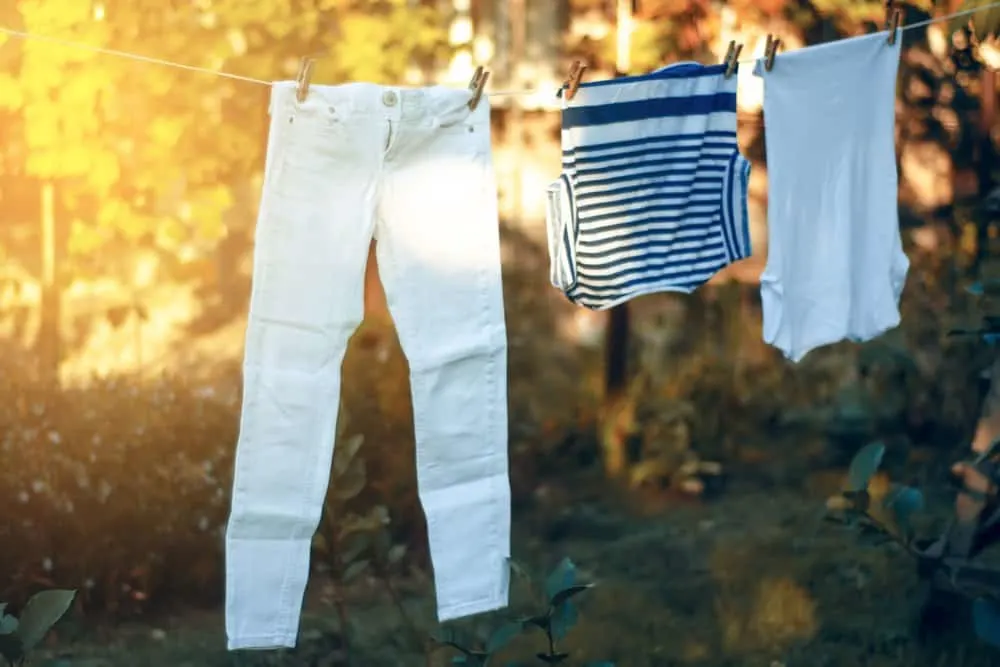
A better option than using your dryer at all? Line dry your clothes instead.
Not only does hanging your clothes outdoors save you money, but they’ll come back inside with a fresher scent than any dryer sheet can give you.
As a bonus, line-dried clothing tends to last longer because they don’t undergo the wear and tear of the dryer. Just be sure you put fade-prone pieces in the shade or hang them inside-out so you don’t lose too much color.
If you’re looking to set up a backyard laundry line, you’ll need a strong rope to tie between two trees or a standalone structure to hang your clothes on instead. Clothespins are required to keep things in place, otherwise you’ll be fishing your socks out of the neighbor’s backyard. Warm weather isn’t needed, though it speeds up the drying process.
But saying that, don’t let bad weather or a small backyard limit your line drying capabilities. It’s also possible to set up a line in your basement, so long as you monitor the space for signs of mildew from too much damp clothing. Occasionally running an air conditioner in the drying room can make a big difference in the downstairs humidity.
Also, keep in mind that line drying doesn’t need to be an all or nothing approach. Even running your dryer for ten fewer minutes and letting your clothes finish drying outdoors will make a difference in your energy usage and electric bill.
Choose Natural Laundry for a More Sustainable Life
This article highlights some of the ways you can naturalize your laundry routine for the benefit of the environment and your health. By incorporating some of these suggestions into your lifestyle, you will live a little lighter on the planet and in your purse.
Pin This To Save For Later


Get the famous Rural Sprout newsletter delivered to your inbox.
Including Sunday musings from our editor, Tracey, as well as “What’s Up Wednesday” our roundup of what’s in season and new article updates and alerts.


